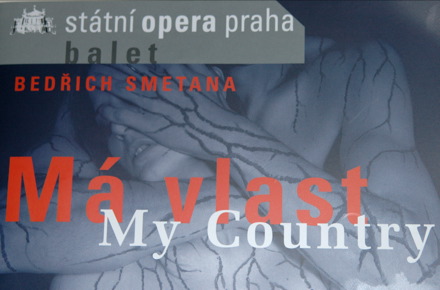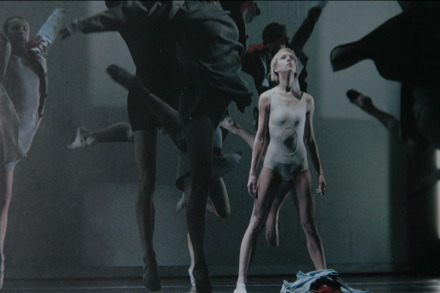Mà Vlast

Mà Vlast ("My Country") is a cycle of symphonic poems by the Bohemian composer Bedrich Smetana, finished in 1879. It is a metaphorical piece about the Czech homeland. If you ever listen to classical "hot hits" radio, you've certainly heard the second song, Vltava ("The Moldau"). Last night I attended the premiere of a new ballet of Mà vlast choreographed and directed by Jan Durovcik, ballet performed by the Prage State Opera Ballet, and with music by the Prague State Opera Orchestra conducted by Petr Vronsky.
I got tickets on the same day, which meant I could only get Kc100 (about $4) tickets. As nosebleed section seats go, these had a pretty good vantage point, to the side of the stage just above the boxes, but the seat had so little legroom that I literally could not sit in it. I had to sit on the top of the seat and lean over the railing. Fortunately we were below the lights, so there was nobody behind us.
The ballet adapts the themes of the music to Czech events of the 20th century, including the Nazi occupation, the expulsion of the Sudeten Germans, and the communist years. The first movement goes in a whirlwind from the origin of man tothe falling of the iron curtain (a transparent screen covered with swastikas, hammers and sickles, crosses, stars, and some symbol I didn't recognize. The Moldau piece was lots of blood, writhing, and doing it. The central focus of the ballet is a couple, a German man and a Czech woman, who are torn apart when the man is forced to leave his wife in 1947. She suffers, alone with her children through the fourth song ("From Czech Meadows and Woods-Seen by a Child"). The fifth and sixth songs, Tábor - Totalitarianism and Blaník - Revolution move from communist housing estates through the revolution of 1989.

The use of fluorescent lights to represent the outward life of the communist era was pretty effective. When the light switches back to stage lighting, movement goes from regimented and drab to organic. Eventually, during forced demonstrations of loyalty, there is occasional dissent which is brought back into line, and then finally the red scarfs are thrown off, the fluorescent lights go out one last time, candles are brought out, and the totalitarian regime ends. The end.
Well, it was a bit heavy-handed, but I thought the staging and dancing were very well-done. Aside from a very uncomfortable seat, I enjoyed it immensely.

